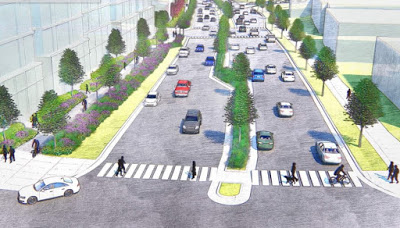Framework for Landmark redevelopment takes shape
 |
| A concept plan for improving Duke Street. |
The City of Alexandria’s plan for the former site of Landmark Mall is taking shape, as an advisory group reached a tentative agreement on a set of recommendations Feb. 27 on such issues as transportation, open space, access, and infrastructure within the site that the Howard Hughes Corp. plans to redevelop as a mixed-use town center.
The recommendations of the Ad Hoc Eisenhower West/Landmark Van Dorn Implementation Advisory Group will be incorporated into a staff report by Alexandria’s Department of Planning and Zoning and presented to the city’s Planning Commission.
The Planning Commission will hold two public hearings on the Landmark plan in April, and the City Council will make a final decision.
Meanwhile, Howard Hughes is talking to companies that might want to occupy space at the new Landmark town center – such as grocery stores, movie theaters, and hotels – but won’t identify specific tenants until there is an agreement, said Mark Bulmash, the company’s senior vice president of development, after the meeting.
Alexandria has agreed to give Howard Hughes some flexibility in the mix of uses – residential, retail, and offices – so it can respond to market demand, while still conforming to a basic plan for the area.
“We want to create a vibrant urban village with a diversity of uses,” Bulmash said. He wouldn’t give a projected date for the start of construction, noting “projects of this size take years.”
At the advisory group meeting, held at the brand-new Patrick Henry Recreation Center in Alexandria’s West End, concerns were raised about building heights, open space, and accessibility for bicyclists and pedestrians, among other issues.
 |
| The central plaza could look like this. |
The plan calls for 3.5 acres of open space, including a central plaza that could be used for special events and that would be open to the public, not just town center residents, said James Farmer, deputy director of the Department of Planning and Zoning, who facilitated the meeting along with planner Ashley Labadie.
In addition, there would be a requirement for each block to have 25 percent open space, which could be above or below grade, such as on top of a parking deck, for example.
The tallest buildings would be next to Interstate 395 and Duke Street, Farmer said. Signature buildings with distinctive architecture would serve as gateways to the town center.
According to Bulmash, the tallest buildings would be 250 feet. That would be about 21 stories, depending on the height of the ceilings.
The group recommended removing the flyover on Duke Street. According to Farmer, it creates an unnecessary barrier and visually blocks the site.
Instead of the current two access points to Landmark, there would three signalized intersections on Duke Street and two on Van Dorn Street.
Duke Street and would be “humanized” with landscaping, wide sidewalks, signalized intersections with crosswalks, and a landscaped median strip. Van Dorn Street would be similarly improved.
Retail on the site is a high priority and should be contiguous and not spread out all over the property, Farmer said.
Several people at the meeting favored a pedestrian bridge over I-395. Others felt VDOT would reject that proposal and instead called for pedestrian and bicycle access to be incorporated into the new ramp, if approved by VDOT,
Here are some additional recommendations from the advisory group:
- Create a street framework on the Landmark site that includes pedestrian connections.
- Have dedicated bike facilities on Duke Street, Van Dorn Street, and some of the internatl streets.
- Pursue a new ramp connection from I-395 to the Landmark site.
- Locate an urban transit hub on the site.
- Place structures in the central plaza, such as a kiosk or a coffee or ice cream shop.
- If feasible, have recreation space on top of the existing garage.
- At least 20 percent of the property should be non-residential.
- The maximum amount of development should be 5.6 million square feet.
- The buildings should have active retail uses on the ground floor.
- There should be a management structure to make sure there aren’t too many retail vacancies.
- There should be some community facilities, such as a fire station or school.
- Design standards for buildings taller than 100 feet should take sun and shade patterns into account.
- There should be a minimum percentage of affordable housing units, and they should be spread out throughout the site.
“There’s a lot we’re trying to balance on this site,” Farmer said. “Many times, a framework plan doesn’t turn out to be feasible when you get to the site plan process. Sometimes cost is a factor. This plan could change even after it’s voted on.”
Other comments from advisory group members – such as whether there will be free parking, whether the plaza should have a fountain, how many students would be expected, and how autonomous vehicles could be accommodated – will be addressed in later phases of the planning process.
Another issue to be discussed in the future: should the property retain the “Landmark” name? A resident of a Landmark condominium urged keeping the name. Another nearby resident disagreed, saying, “The Landmark name has a sad connotation. The mall has been dying for years. A new name is needed to go along with the exciting new development.”


Keep the Landmark name. It keeps the history AND progression of the area. Renaming is not always good, i.e., Crystal City to National Landing….really?????
I heard that in the interim they will rename Landmark to the Grand Dump of Alexandria!
Most of these suggestions can be summed up into one word – GRIDLOCK. That area is bad enough now. Sure, add more people, houses, businesses, pedestrians, busses, bikes and lights to the the current toxic mix without increasing any vehicle capacity on the LRT or Van Dorn. What could go wrong with that?!?!?